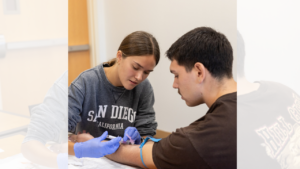“A Swing Bed referral is what we need to have if you’re not an inpatient at our hospital. Those referrals come from larger hospitals. Swing bed care, for many patients, is a transition in their recovery from a surgery, injury, or other medical issue.”
That’s Chelcea Miller, a social worker and case manager at CCMH.
“My job is to ensure that, when patients leave our facility, they have all the resources they need. It could be adaptive equipment, home health services, or on occasion, nursing home or assisted living care. My work benefits the patients. A big part of my job is to advocate for the patients. I go to the ER, I go down to the clinic, I go wherever I’m needed to provide resources to patients.”
The Swing Bed Program operates only in Critical Access Hospitals (CAHs) like CCMH. Miller says, like any government program, there are certain guidelines that need to be met before qualifying for the Swing Bed program.
“Patients must have three overnight acute stays. Observation nights do not count toward your three overnight stays. It is necessary to have those three acute nights for Medicare to cover your Swing Bed.”
The Swing Bed Program is for people that just aren’t ready to return home yet.
“It could be a need for on-going IV antibiotics or physical therapy, or occupational therapy. For example, you have a hip surgery. You’re not quite ready to go home yet. That’s where the Swing Bed program comes in as the transition in your recovery. CCMH can offer physical therapy to build up your strength. The goal of the Swing Bed program is to help you transition to a permanent placement.”
Miller says the Swing Bed program is meant as a temporary solution to an immediate need.
“Sometimes people go from our program at CCMH and transfer to a nursing home as a Swing Bed patient. Medicare will then cover that transfer to continue their care. Generally speaking, when someone comes to the Swing Bed program at CCMH, it’s one to two weeks. If further care is needed. that’s when we look at a nursing home option to continue Swing Bed care. This can last an additional month or more. Patients do get a hundred days a year in the program, which doesn’t seem like a lot, but it is. Swing Bed provides the transitional care between going through a medical procedure, convalescing, then going home.”
Home health care can also be a part of the transition from Swing Bed care.
“Rather than the nursing home care, it could be transitioning directly back home with home health care to continue therapy a couple times a week or going home and continuing outpatient physical therapy at the hospital. Patients are given an option for home health if it’s medically appropriate or outpatient services through the hospital, a patient can either have home health or participate in outpatient, they cannot have both services at the same time.”
Miller relates that Swing Bed program has processes that must be followed.
“Any referral received for Swing Bed goes through every related department, like pharmacy and physical therapy, to make sure we have available all of the resources the patient will need. Then, at that point, we determine if the referral is something that’s acceptable for our Swing Bed program.”
While the Swing Bed program works with traditional Medicare, it can also work with Medicare Advantage plans or with Medicaid.
“As long as the requirements for the Swing Bed program are met, traditional Medicare insurance will provide the coverage in the hospital and, if necessary, in the nursing home. A Medicare Advantage plan is treated a bit differently. The insurance company with the Medicare Advantage plan gets to decide if you qualify for the program. Medicare Advantage wants the patient to get the care they need. It’s just that the Medicare Advantage insurance companies have additional criteria that have to be met. Medicaid programs in Iowa work much in the same way as the Medicare Advantage plans, whether that’s Molina Healthcare of Iowa, Iowa Total Care, or Wellpoint Iowa, Inc. (formerly Amerigroup Iowa, Inc.).”
Miller says patients or families interested in the Swing Bed program start the process by talking to their case manager or social worker at the referring facility.
“if the patient meets the criteria for the Swing Bed program, that facility sends us the referral. The referral contains the procedure the patient received, how long the patient has been hospitalized, the primary doctor, any kind of insurance, and the expected time frame for recovery. It is a requirement that a facility or a physician is the one who is referring the patient to us for this particular program. We also need a physician’s order for skilled therapy. Most physicians provide that order as an extra preventative step we take to eliminate readmissions.”
This is a program that really works well for the people who can fit within the criteria according to Miller.
“This is an absolutely great program. I do think that the more people understand it and know the options for Swing Bed, the more patients and families will participate. Keep in mind, the most important thing as patients transition in their recovery is safety. Safety is a huge thing. No one wants a loved one going home, falling, getting injured. It’s peace of mind knowing that when your family member returns home, they’re better equipped to succeed.”
For more information regarding the Swing Bed program as a transition to recovery at CCMH, contact Chelcea Miller by calling the main number at 712-265-2500.


